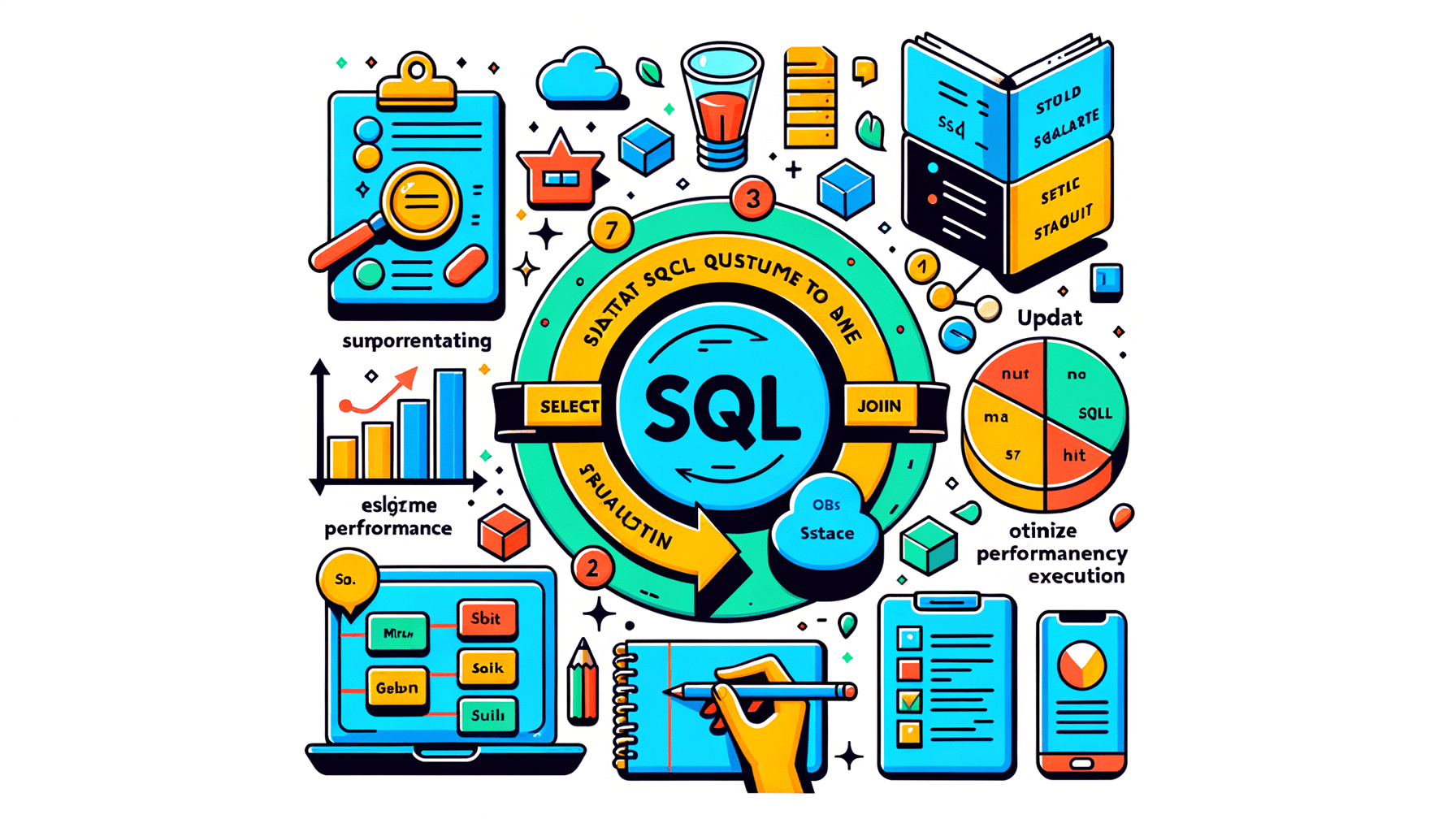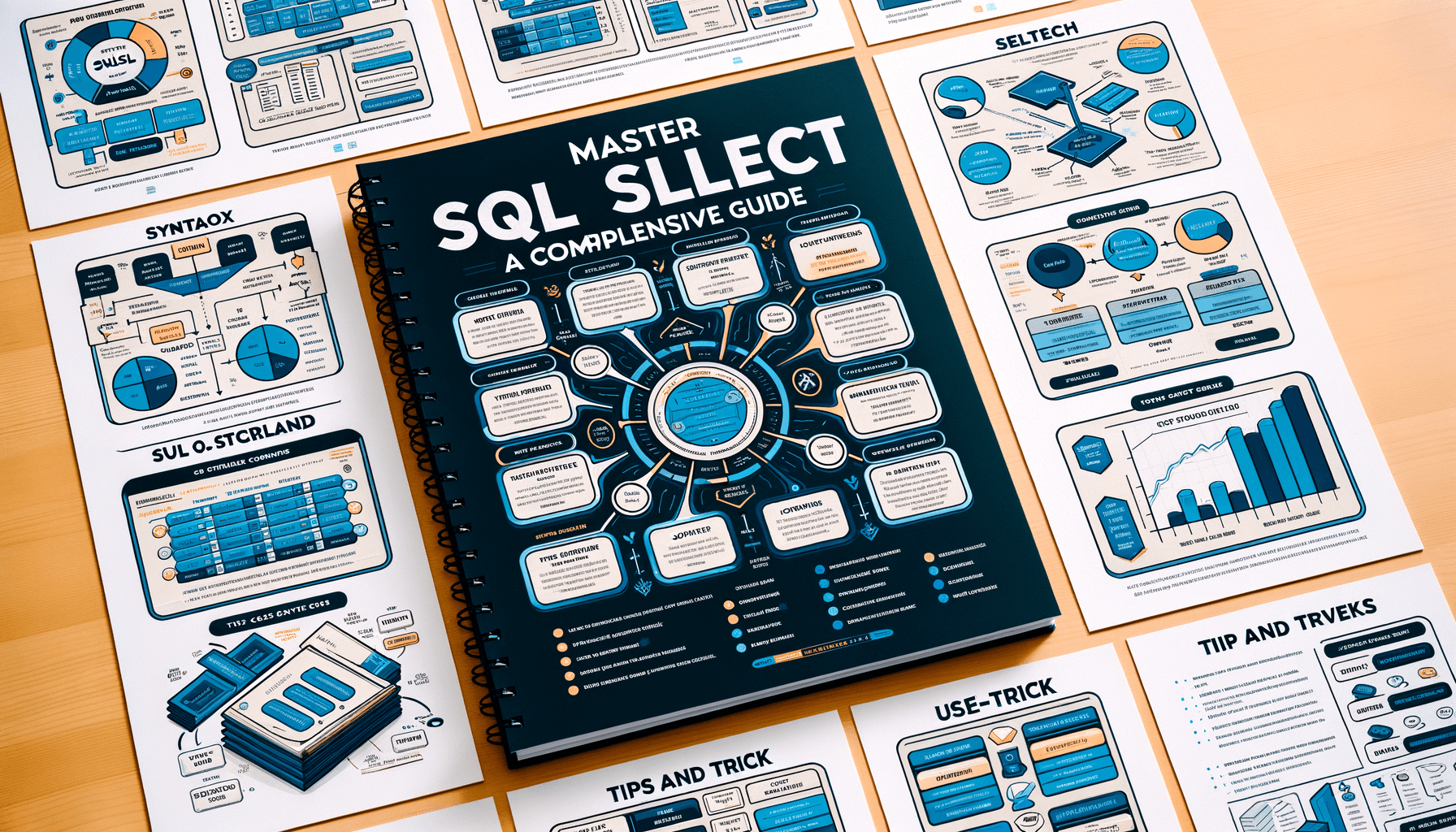A big variety of articles and resources

Mastering Data Management: Comprehensive SQL Training for Beginners and Experts
 Sia Author and Instructor
Learn SQL
Sia Author and Instructor
Learn SQL
13 minute read
Mastering SQL is a crucial skill for anyone dealing with data. Whether you're a beginner or an expert, understanding SQL can help you manage and analyze data more efficiently. This guide will walk you through the basics and advanced techniques of SQL, ensuring you have a solid foundation and the skills needed for real-world applications.
Key Takeaways
- Learn the foundational concepts of SQL, including relational databases and basic commands.
- Explore advanced SQL functions and techniques like aggregate functions and subqueries.
- Understand how to manipulate and transform data using SQL commands.
- Discover methods to optimize SQL queries for better performance.
- Get insights into database design, normalization, and how to apply SQL in various professional scenarios.
Foundational Concepts in SQL
Understanding Relational Databases
Relational databases are the backbone of many applications. They store data in tables, which are organized into rows and columns. Each table represents a different entity, and relationships between tables are established through keys. Understanding how these relationships work is crucial for effective database management.
Basic SQL Syntax and Commands
SQL, or Structured Query Language, is used to interact with relational databases. The basic commands include SELECT, INSERT, UPDATE, and DELETE. These commands allow you to retrieve, add, modify, and remove data from tables. Here's a quick overview:
- SELECT: Retrieves data from one or more tables.
- INSERT: Adds new rows to a table.
- UPDATE: Modifies existing data in a table.
- DELETE: Removes data from a table.
Data Types and Their Uses
In SQL, data types define the kind of data that can be stored in a column. Common data types include INT for integers, VARCHAR for variable-length strings, and DATE for dates. Choosing the right data type is important because it affects the storage requirements and the efficiency of the database. For example, using an INT data type for age is more efficient than using a VARCHAR data type.
Advanced SQL Functions and Techniques
Using Aggregate Functions
Aggregate functions are essential for summarizing data. They allow you to perform calculations on multiple rows of a table's column and return a single value. Common aggregate functions include SUM, AVG, COUNT, MIN, and MAX. Mastering these functions is crucial for effective data analysis and reporting.
Implementing Subqueries
Subqueries, also known as nested queries, are queries within another SQL query. They can be used to perform complex operations in a more readable and manageable way. Subqueries can be found in SELECT, INSERT, UPDATE, or DELETE statements. They are particularly useful for breaking down complex problems into simpler parts.
Advanced Joins and Set Operations
Joins are used to combine rows from two or more tables based on a related column. Advanced joins, such as INNER JOIN, LEFT JOIN, RIGHT JOIN, and FULL OUTER JOIN, help in managing database relationships effectively. Set operations like UNION, INTERSECT, and EXCEPT allow you to perform operations on multiple result sets. Mastering advanced joins and set operations is essential for comprehensive database management.
Building a strong foundation in SQL is essential for any tech role, enhancing versatility and confidence in database tasks.
Data Manipulation and Transformation
Inserting, Updating, and Deleting Data
In SQL, data manipulation is a fundamental skill. You can insert new records, update existing ones, or delete data that is no longer needed. These operations are essential for maintaining the accuracy and relevance of your database.
Using the WHERE Clause for Filtering
The WHERE clause is a powerful tool for filtering data. It allows you to specify conditions that must be met for records to be selected. This is crucial for efficient data management and ensures that you only work with the data you need.
Data Transformation with SQL
Data transformation involves changing the format, structure, or values of data. SQL provides various functions and techniques to transform data, making it suitable for analysis or reporting. This skill is vital for any SQL developer looking to handle complex data challenges effectively.
Mastering these skills enhances efficiency, maintainability, and the ability to handle complex data challenges, ensuring effective data management and analysis in modern database environments.
Optimizing SQL Queries for Performance
Indexing Strategies
When it comes to speeding up SQL queries, indexing is a crucial technique. Indexes help the database find rows much faster than without them. However, it's important to use them wisely, as too many indexes can slow down write operations. Generally, you should index columns that are frequently used in WHERE clauses and join conditions.
Query Execution Plans
Understanding how your queries are executed can provide insights into performance bottlenecks. By examining the query execution plan, you can see how the database engine processes your SQL statements. This helps in identifying inefficient operations, such as full table scans, and allows you to make necessary adjustments.
Performance Tuning Techniques
Performance tuning involves a variety of strategies to make your SQL queries run faster. Some common techniques include:
- Optimizing Joins: Ensure that joins are performed on indexed columns.
- Reducing Subqueries: Whenever possible, replace subqueries with joins or other more efficient operations.
- Limiting Result Sets: Use the LIMIT clause to restrict the number of rows returned.
Efficient SQL queries are essential for maintaining high performance in database applications. By applying these techniques, you can significantly improve the speed and efficiency of your SQL operations.
Database Design and Normalization
Principles of Database Design
When designing a database, it's important to follow certain principles to ensure it is efficient and scalable. Good design helps in managing data effectively and makes future updates easier. One key principle is to avoid redundancy, which means not storing the same piece of data in multiple places.
Normalization and Denormalization
Normalization is a process that organizes data to reduce redundancy and improve data integrity. It involves dividing a database into two or more tables and defining relationships between them. This makes the database more efficient and easier to maintain. However, sometimes denormalization is used to improve performance by combining tables.
Entity-Relationship Modeling
Entity-Relationship (ER) modeling is a technique used to visualize the structure of a database. It helps in understanding how different entities (like tables) relate to each other. ER models are useful for planning and can be a great tool for communicating the database design to others.
Understanding these concepts is crucial for efficient database management, allowing for effective data updates and deletions, and ensuring scalability and performance in handling complex queries.
SQL for Data Analysis and Reporting
Creating and Using Views
Views in SQL are virtual tables that provide a way to simplify complex queries. They can be used to present data in a specific format without altering the actual tables. Views are particularly useful for data analysis as they allow you to focus on the data you need without worrying about the underlying structure.
Generating Reports with SQL
SQL is a powerful tool for generating detailed reports. By using SELECT statements, JOINs, and aggregate functions, you can create comprehensive reports that provide valuable insights. Here are some steps to generate a report:
- Identify the data you need.
- Write a query to retrieve the data.
- Use aggregate functions to summarize the data.
- Format the results for readability.
Advanced Analytical Functions
Advanced analytical functions in SQL, such as window functions, allow you to perform complex calculations over a set of rows. These functions are essential for tasks like calculating running totals, moving averages, and ranking data. Mastering these functions can significantly enhance your data analysis capabilities.
SQL is not just a query language; it's a powerful tool for data analysis and reporting. By mastering SQL, you can unlock the full potential of your data and make informed decisions based on accurate insights.
SQL in Application Development
Embedding SQL in Programming Languages
When developing applications, embedding SQL directly into your code can be a powerful tool. This approach allows you to interact with databases seamlessly. Embedding SQL helps in executing queries, fetching data, and performing updates without leaving the programming environment. This integration is crucial for creating dynamic and data-driven applications.
Using ORM Frameworks
Object-Relational Mapping (ORM) frameworks simplify database interactions by allowing developers to work with database records as if they were objects in their code. This abstraction layer reduces the need for writing raw SQL queries, making the code cleaner and easier to maintain. Popular ORM frameworks include Hibernate for Java, Django ORM for Python, and Entity Framework for .NET.
Database Connectivity and APIs
Connecting to databases and using APIs is essential for modern application development. APIs provide a standardized way to interact with databases, enabling operations like CRUD (Create, Read, Update, Delete). Database connectivity can be achieved using various drivers and libraries specific to the programming language in use. For instance, JDBC for Java, psycopg2 for Python, and ADO.NET for .NET applications.
Mastering these techniques not only enhances your development skills but also ensures that your applications are robust, scalable, and efficient.
Security and User Management in SQL
Implementing Access Controls
In SQL, managing who can access what data is crucial. Access controls help ensure that only authorized users can view or modify data. This involves setting up user roles and permissions. For example, you might have roles like 'Admin', 'Editor', and 'Viewer', each with different levels of access.
Data Encryption Techniques
To protect sensitive information, SQL databases often use encryption. Encryption converts data into a coded format that can only be read by someone with the correct decryption key. There are two main types of encryption: at rest and in transit. At rest encryption protects data stored on disk, while in transit encryption secures data as it travels over the network.
Auditing and Monitoring SQL Databases
Keeping track of who did what and when is essential for security. Auditing involves recording database activities, such as logins, changes to data, and permission alterations. Monitoring tools can alert you to suspicious activities, helping you respond quickly to potential threats.
Effective security and user management in SQL not only protect data but also ensure compliance with regulations and standards.
Real-World SQL Applications
Case Studies in Business Applications
In the business world, SQL is a powerful tool for managing and analyzing data. For instance, retail companies use SQL to track sales, manage inventory, and analyze customer behavior. Mastering these skills is essential for effective data manipulation and retrieval, enabling better performance in data analytics and web development.
SQL in Data Warehousing
Data warehousing involves collecting and managing data from different sources to provide meaningful business insights. SQL plays a crucial role in this process by allowing users to query large datasets efficiently. This is particularly important for businesses that rely on data-driven decision-making.
Handling Big Data with SQL
With the rise of big data, SQL has adapted to handle larger and more complex datasets. Techniques such as partitioning and indexing help in managing big data effectively. This ensures that queries run smoothly and return results quickly, even with vast amounts of data.
Working with real-world datasets enhances SQL learning by covering advanced topics like complex queries, database optimization, and SQL for data analysis.
In summary, SQL's versatility makes it indispensable in various real-world applications, from business analytics to big data management.
SQL Best Practices and Industry Standards
Coding Standards and Conventions
When writing SQL, it's important to follow coding standards and conventions. This helps maintain consistency and readability across different projects. For example, always use uppercase for SQL keywords and lowercase for table and column names. This makes your code easier to read and understand.
Error Handling and Debugging
Effective error handling and debugging are crucial for maintaining robust SQL applications. Use try-catch blocks to manage exceptions and ensure your queries are error-free. Proper error handling can save you a lot of time and headaches in the long run.
Maintaining Data Integrity
Maintaining data integrity is essential for any database system. Use constraints like primary keys, foreign keys, and unique constraints to ensure the accuracy and reliability of your data. Regularly audit your database to check for any inconsistencies or anomalies.
Following these best practices not only improves the quality of your SQL code but also enhances the overall performance and reliability of your database systems.
Preparing for SQL Certification Exams
Overview of Certification Paths
When preparing for SQL certification exams, it's important to understand the different paths available. Certifications can range from beginner to expert levels, each focusing on various aspects of SQL and database management. Choosing the right certification can significantly impact your career trajectory.
Study Tips and Resources
Effective study habits are crucial for success. Here are some tips to help you prepare:
- Create a study schedule and stick to it.
- Use a mix of resources like books, online courses, and practice exams.
- Join study groups or forums to discuss topics and clarify doubts.
Utilizing diverse resources ensures a well-rounded understanding of the material.
Practice Exams and Assessments
Taking practice exams is one of the best ways to prepare. They help you get familiar with the exam format and identify areas where you need improvement. Aim to take multiple practice tests to build confidence and improve your time management skills.
Consistent practice and assessment are key to mastering SQL certification exams.
Getting ready for your SQL certification exams can be a big step towards a successful tech career. Our website offers a variety of courses to help you master SQL and ace your exams. From beginner to advanced levels, we have something for everyone. Don't wait, start your journey today and unlock your potential!
Conclusion
Mastering SQL is a journey that offers immense rewards for both beginners and seasoned professionals. Through comprehensive training, you can develop the skills needed to manage databases efficiently, solve real-world problems, and drive data-driven decisions. Whether you're just starting out or looking to deepen your expertise, our courses provide the practical knowledge and hands-on experience necessary to excel in the field of data management. By investing in your SQL education, you are setting yourself up for success in a data-centric world.
Frequently Asked Questions
What is SQL and why is it important?
SQL stands for Structured Query Language. It's used to manage and manipulate databases. It's important because it allows you to store, retrieve, and analyze data efficiently.
Do I need any prior knowledge to start learning SQL?
No, you don't need any prior knowledge. Our course covers everything from the basics to advanced topics, making it suitable for beginners and experts alike.
How long will it take to learn SQL?
The time it takes to learn SQL varies depending on your pace. With consistent practice, you can grasp the basics in a few weeks and master advanced concepts in a few months.
Can I practice SQL without a database?
Yes, there are many online platforms that offer SQL practice environments. You can also download sample databases to practice on your own computer.
What are some common SQL commands I should know?
Some common SQL commands include SELECT, INSERT, UPDATE, DELETE, and CREATE. These commands help you perform basic operations on a database.
How is SQL used in real-world applications?
SQL is used in various fields like data analysis, software development, and business intelligence. It helps in making data-driven decisions and managing large datasets efficiently.
What is a JOIN in SQL?
A JOIN in SQL is used to combine rows from two or more tables based on a related column. Common types of JOINs include INNER JOIN, LEFT JOIN, and RIGHT JOIN.
Is SQL only for data scientists and analysts?
No, SQL is useful for anyone who works with data, including software developers, database administrators, and business analysts. It's a versatile skill that can benefit many roles.
Related Articles

Mastering the Basics: SQL for Beginners
15 minute read






